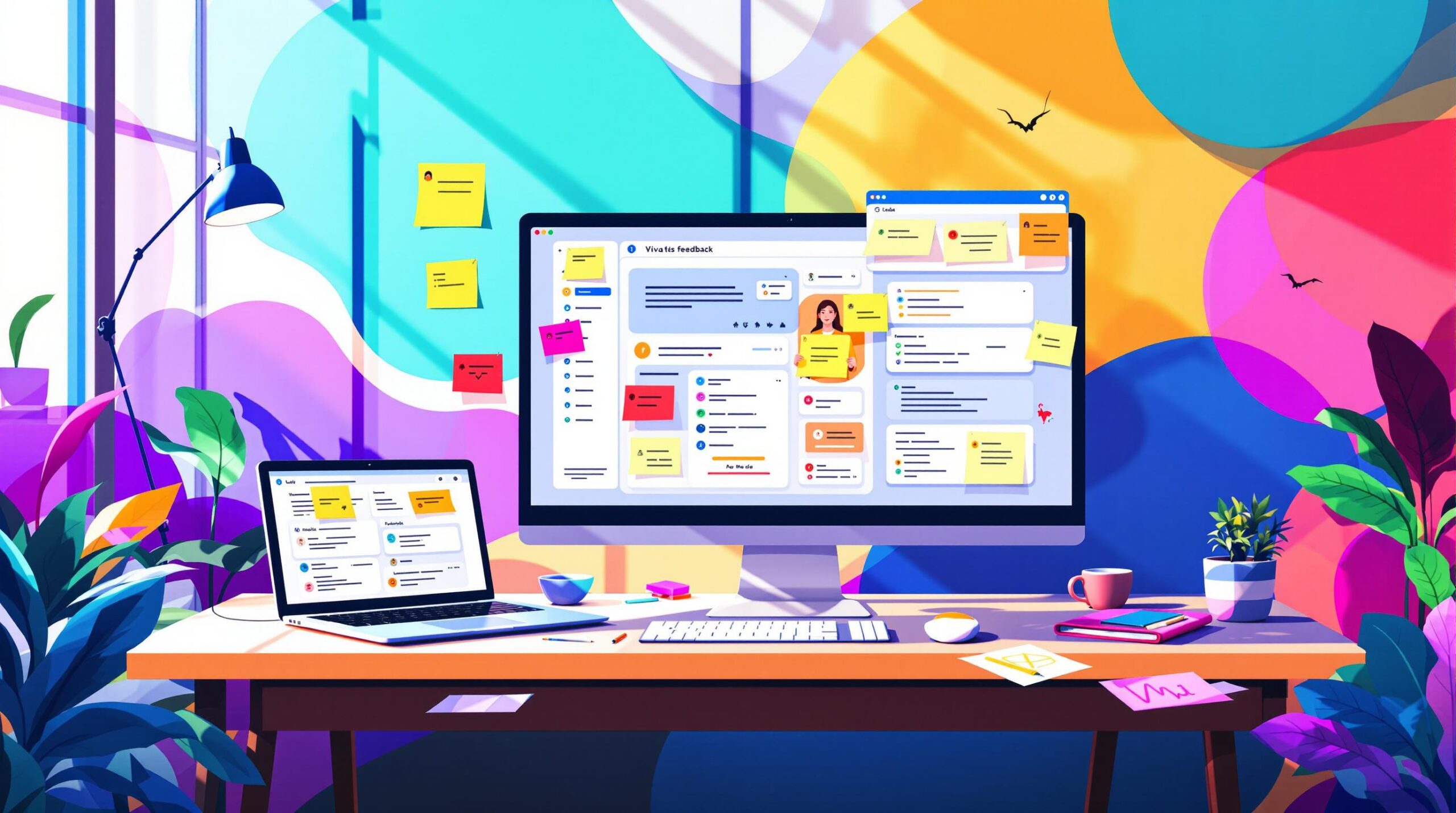Visual feedback tools outperform email for managing project feedback, especially in visual and digital workflows. Here’s why:
- Centralized Feedback: Keeps all feedback in one place, avoiding scattered email threads.
- Precise Annotations: Directly mark areas on files for clear and actionable feedback.
- Real-Time Collaboration: Enables instant responses and faster decision-making.
- File Management: Handles large files and tracks versions automatically.
- Progress Tracking: Offers unified dashboards for monitoring updates and progress.
Quick Comparison
| Aspect | Visual Feedback Tools | |
|---|---|---|
| Organization | Centralized dashboard | Scattered threads |
| Feedback Clarity | Annotate directly on files | Text descriptions prone to errors |
| Version Control | Automatic tracking | Manual tracking |
| Collaboration | Real-time updates and notifications | Delayed responses |
| File Management | Built-in tools for large files | Limited by attachment sizes |
| Progress Tracking | Real-time dashboards | Manual follow-ups |
For teams tackling complex projects, visual feedback tools simplify collaboration, reduce delays, and improve productivity. Email, while suitable for simple communication, often falls short in managing feedback for intricate workflows.
BugSmash Review: The Best Visual Feedback Tool for 2024

Challenges of Using Email for Feedback
Professionals spend up to 2.5 hours daily managing email [1], with a large chunk of that time wasted on inefficient feedback workflows. When teams handle complex projects, these inefficiencies can seriously disrupt collaboration.
Disorganized Communication
Email feedback tends to scatter across multiple threads, leading to version mix-ups, misplaced comments, and difficulty keeping track of everyone’s input – especially when several stakeholders are involved. This lack of organization makes it hard to get a clear picture of changes and suggestions, leaving project managers scrambling to piece everything together.
No Real-Time Interaction
Email lacks the ability to facilitate real-time discussions. This means simple clarifications are delayed, creating bottlenecks that slow down projects. Teams working on time-sensitive tasks often struggle the most, as they can’t make quick decisions or iterate efficiently without timely responses.
File Sharing Issues
Email’s file-sharing limitations add another layer of frustration. Common problems include:
- File size restrictions that require compressing or splitting files
- Multiple versions of the same file floating around, causing confusion
- No easy way to track who has reviewed or accessed specific files
- Attachment overload, leading to storage problems and cluttered inboxes
These challenges make email feedback systems a poor fit for fast-moving digital projects that demand clear communication and quick turnarounds. The inefficiencies often result in higher project costs, missed deadlines, and frustrated teams [1][2]. This is why more teams are moving toward visual feedback tools to simplify collaboration and improve workflow.
sbb-itb-54a62c3
Benefits of Visual Feedback Tools
Visual feedback tools have changed the way teams work on digital projects, offering a more efficient alternative to traditional email-based feedback systems.
Centralized Feedback
These platforms bring all project feedback into one place, replacing scattered email threads with a single, organized system. For example, BugSmash allows teams to manage feedback across websites, mobile apps, videos, and PDFs, all within one platform [4][2].
Centralizing feedback offers clear advantages:
- Easy access to earlier feedback and version history
- Avoidance of duplicate comments and confusion among stakeholders
On top of that, these tools make feedback clearer by enabling precise annotations.
Precise Annotations
With visual feedback tools, team members can mark specific areas directly, eliminating the need for lengthy and unclear email descriptions. This makes feedback more actionable and easier to implement.
"The power of visual feedback in web development lies in its capacity to transform abstract ideas into concrete outcomes" [3].
Visual annotations help teams:
- Clarify feedback and avoid misunderstandings
- Minimize the chances of misinterpretation
- Speed up the revision process
- Keep a clear record of all changes
This level of clarity becomes even more effective when combined with real-time collaboration.
Real-Time Collaboration
Studies reveal that real-time collaboration tools, including visual feedback platforms, can increase productivity by up to 25% and reduce project timelines by 30% [1]. Team members can respond and act immediately, cutting down delays caused by email back-and-forths.
Features that enable instant collaboration include:
- Real-time commenting and discussions
- Notifications about updates as they happen
- Live collaboration sessions
- Quick sharing of updated versions
Unified Feedback Dashboards
Unlike the scattered nature of email threads, dashboards in visual feedback tools provide a clear, unified view of all feedback activities. This ensures no input is overlooked and helps keep projects on track.
Key dashboard features include:
- Real-time updates on feedback implementation
- A clear summary of project progress
- Easy identification of bottlenecks
- Streamlined progress reporting for stakeholders
Comparing Visual Feedback Tools and Email
Visual feedback tools offer a clear advantage over traditional email communication, especially when it comes to managing projects. Research shows that teams using these tools can cut feedback loops by up to 50% and reduce project timelines by 30% compared to relying on email [1].
For example, a web development agency using BugSmash can manage to reduce email threads by 75% and complete projects 25% faster.
Here’s how visual feedback tools and email stack up in key areas of project management:
| Aspect | Visual Feedback Tools | |
|---|---|---|
| Organization | Centralized dashboard for all feedback | Scattered across multiple threads and folders |
| Feedback Clarity | Annotate directly on files with visual context | Text descriptions prone to misinterpretation |
| Version Control | Automatic tracking with full history | Manual tracking via file names and dates |
| Collaboration | Real-time updates and instant notifications | Delayed responses; risk of missed messages |
| File Management | Direct uploads with built-in annotation tools | Limited by attachment sizes; external hosting |
| Progress Tracking | Real-time status updates and monitoring | Manual tracking through follow-up emails |
| Best Use Cases | Visual projects, team collaboration, iterative feedback | Simple text communication, formal correspondence |
What sets visual feedback tools apart is their ability to integrate with other software, making them an excellent fit for modern workflows. This integration is especially helpful for remote teams, where clear and efficient communication is critical.
For large-scale projects like website redesigns, visual feedback tools simplify tracking and collaboration. In contrast, email threads can quickly become chaotic and difficult to manage.
Conclusion: Picking the Right Feedback Tool
Visual feedback tools have reshaped how teams handle digital projects, making feedback loops quicker and collaboration smoother. Tools like BugSmash highlight these benefits by centralizing feedback from different media, offering real-time updates, and allowing detailed annotations directly on digital assets.
Research suggests that selecting the right feedback tool can heavily influence project outcomes. Here are a few things to keep in mind when evaluating options:
- Project Type: Ideal for visual or multimedia-heavy projects requiring detailed annotations.
- Team Size: Larger teams often gain the most from centralized feedback and real-time collaboration features.
- Workflow Integration: Make sure the tool works seamlessly with your team’s current tools and processes.
After reviewing these factors, you’ll be better equipped to decide if a visual feedback tool fits your team. Success hinges on proper team training and consistent use. These tools can help replace inefficient email chains and boost productivity for even the most complex digital projects.




